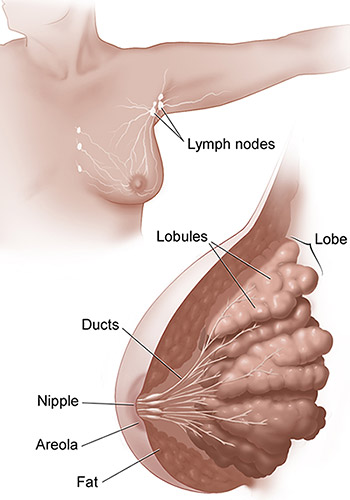Statistics at a Glance
At a Glance
Estimated New Cases in 2025 316,950
% of All New Cancer Cases 15.5%
Estimated Deaths in 2025 42,170
% of All Cancer Deaths 6.8%
5-Year
Relative Survival
| Year | Rate of New Cases — SEER 8 | Rate of New Cases — SEER 12 | Death Rate — U.S. | 5-Year Relative Survival — SEER 8 | ||||
|---|---|---|---|---|---|---|---|---|
| Observed | Modeled Trend | Observed | Modeled Trend | Observed | Modeled Trend | Observed | Modeled Trend | |
| 1975 | 105.94 | 103.49 | - | - | 31.45 | 31.49 | 76.16% | 75.64% |
| 1976 | 102.11 | 103.32 | - | - | 31.83 | 31.60 | 75.83% | 75.83% |
| 1977 | 101.68 | 103.14 | - | - | 32.49 | 31.72 | 76.47% | 76.01% |
| 1978 | 102.00 | 102.97 | - | - | 31.75 | 31.83 | 75.42% | 76.20% |
| 1979 | 102.61 | 102.80 | - | - | 31.23 | 31.94 | 75.24% | 76.39% |
| 1980 | 103.22 | 102.62 | - | - | 31.70 | 32.06 | 75.88% | 76.57% |
| 1981 | 105.06 | 102.45 | - | - | 31.93 | 32.17 | 76.29% | 76.75% |
| 1982 | 105.32 | 106.92 | - | - | 32.21 | 32.29 | 77.70% | 76.93% |
| 1983 | 110.04 | 111.58 | - | - | 32.09 | 32.40 | 77.63% | 77.11% |
| 1984 | 115.76 | 116.45 | - | - | 32.91 | 32.52 | 79.21% | 78.93% |
| 1985 | 123.79 | 121.53 | - | - | 32.99 | 32.63 | 79.51% | 80.63% |
| 1986 | 126.92 | 126.82 | - | - | 32.88 | 32.75 | 81.45% | 82.20% |
| 1987 | 134.03 | 132.36 | - | - | 32.67 | 32.87 | 83.95% | 83.66% |
| 1988 | 131.13 | 131.81 | - | - | 33.22 | 32.98 | 85.46% | 85.01% |
| 1989 | 127.18 | 131.26 | - | - | 33.25 | 33.10 | 84.84% | 85.35% |
| 1990 | 131.04 | 130.72 | - | - | 33.16 | 33.22 | 85.50% | 85.68% |
| 1991 | 132.13 | 130.18 | - | - | 32.71 | 32.63 | 86.46% | 86.00% |
| 1992 | 131.29 | 129.64 | 129.15 | 126.33 | 31.67 | 32.06 | 86.64% | 86.32% |
| 1993 | 128.86 | 129.11 | 126.73 | 128.07 | 31.41 | 31.49 | 86.33% | 86.63% |
| 1994 | 131.31 | 131.24 | 128.69 | 129.83 | 30.93 | 30.93 | 87.40% | 86.93% |
| 1995 | 132.01 | 133.40 | 130.24 | 131.62 | 30.56 | 30.39 | 87.33% | 87.23% |
| 1996 | 134.52 | 135.59 | 132.41 | 133.43 | 29.51 | 29.40 | 87.23% | 88.19% |
| 1997 | 137.92 | 137.83 | 135.78 | 135.26 | 28.22 | 28.44 | 89.38% | 89.08% |
| 1998 | 141.61 | 140.10 | 138.82 | 137.12 | 27.55 | 27.51 | 90.27% | 89.90% |
| 1999 | 142.31 | 142.41 | 138.76 | 139.01 | 26.61 | 26.99 | 90.02% | 90.10% |
| 2000 | 136.70 | 139.46 | 134.07 | 136.11 | 26.65 | 26.48 | 90.43% | 90.28% |
| 2001 | 139.42 | 136.58 | 135.93 | 133.27 | 26.02 | 25.97 | 90.25% | 90.47% |
| 2002 | 136.70 | 133.75 | 133.10 | 130.49 | 25.63 | 25.48 | 90.95% | 90.65% |
| 2003 | 126.71 | 130.99 | 123.69 | 127.76 | 25.28 | 24.99 | 90.63% | 90.83% |
| 2004 | 128.17 | 128.28 | 124.58 | 125.10 | 24.50 | 24.52 | 90.74% | 91.00% |
| 2005 | 127.07 | 125.63 | 124.52 | 122.49 | 24.15 | 24.05 | 91.33% | 91.18% |
| 2006 | 126.38 | 126.43 | 122.54 | 123.23 | 23.56 | 23.59 | 91.75% | 91.34% |
| 2007 | 128.71 | 127.24 | 126.23 | 123.98 | 22.97 | 23.14 | 91.71% | 91.51% |
| 2008 | 129.42 | 128.05 | 126.75 | 124.73 | 22.56 | 22.70 | 91.57% | 91.67% |
| 2009 | 130.62 | 128.87 | 127.33 | 125.49 | 22.25 | 22.27 | 92.08% | 91.83% |
| 2010 | 127.84 | 129.70 | 123.90 | 126.25 | 21.94 | 21.84 | 91.74% | 91.99% |
| 2011 | 131.03 | 130.53 | 127.37 | 127.02 | 21.60 | 21.59 | 92.40% | 92.14% |
| 2012 | 130.16 | 131.37 | 126.71 | 127.79 | 21.37 | 21.33 | 91.94% | 92.29% |
| 2013 | 131.21 | 132.21 | 127.37 | 128.57 | 20.89 | 21.08 | 92.32% | 92.44% |
| 2014 | 132.44 | 133.05 | 126.92 | 129.35 | 20.74 | 20.83 | 92.21% | 92.59% |
| 2015 | 132.75 | 133.90 | 129.11 | 130.13 | 20.54 | 20.59 | 92.97% | 92.73% |
| 2016 | 132.54 | 134.76 | 128.90 | 130.92 | 20.31 | 20.34 | 93.14% | 92.87% |
| 2017 | 133.85 | 135.62 | 130.24 | 131.72 | 20.18 | 20.11 | 93.20% | 93.01% |
| 2018 | 135.54 | 136.49 | 131.89 | 132.52 | 20.09 | 19.87 | - | 93.14% |
| 2019 | 138.77 | 137.37 | 135.37 | 133.32 | 19.75 | 19.63 | - | 93.28% |
| 2020 | 125.61 | 138.25 | 121.83 | 134.13 | 19.45 | 19.40 | - | 93.41% |
| 2021 | 143.76 | 139.13 | 138.90 | 134.95 | 19.23 | 19.18 | - | 93.53% |
| 2022 | 139.13 | 140.02 | 135.30 | 135.77 | 18.89 | 18.95 | - | 93.66% |
| 2023 | - | - | - | - | 18.55 | 18.73 | - | - |
New cases come from SEER 12. Deaths come from U.S. Mortality.
All Races, Females. Rates are Age-Adjusted.
Modeled trend lines were calculated from the underlying rates using the Joinpoint Trend Analysis Software.
The 2020 incidence rate is displayed but not used in the fit of the trend line(s). Impact of COVID on SEER Cancer Incidence 2020 data
New cases are also referred to as incident cases in other publications. Rates of new cases are also referred to as incidence rates.
Rate of New Cases and Deaths per 100,000: The rate of new cases of female breast cancer was 130.8 per 100,000 women per year. The death rate was 19.2 per 100,000 women per year. These rates are age-adjusted and based on 2018–2022 cases and 2019–2023 deaths.
Lifetime Risk of Developing Cancer: Approximately 13.0 percent of women will be diagnosed with female breast cancer at some point during their lifetime, based on 2018–2021 data, excluding 2020 due to COVID.
Prevalence of This Cancer: In 2022, there were an estimated 4,091,181 women living with female breast cancer in the United States.
Survival Statistics
How Many People Survive 5 Years Or More after Being Diagnosed with Female Breast Cancer?
Relative survival is an estimate of the percentage of patients who would be expected to survive the effects of their cancer. It excludes the risk of dying from other causes. Because survival statistics are based on large groups of people, they cannot be used to predict exactly what will happen to an individual patient. No two patients are entirely alike, and treatment and responses to treatment can vary greatly.

5-Year
Relative Survival
Based on data from SEER 21 (Excluding IL) 2015–2021. Gray figures represent those who have died from female breast cancer. Green figures represent those who have survived 5 years or more.
Survival by Stage
Cancer stage at diagnosis, which refers to extent of a cancer in the body, determines treatment options and has a strong influence on the length of survival. In general, if the cancer is found only in the part of the body where it started it is localized (sometimes referred to as stage 1). If it has spread to a different part of the body, the stage is regional or distant. The earlier female breast cancer is caught, the better chance a person has of surviving five years after being diagnosed. For female breast cancer, 63.8% are diagnosed at the local stage. The 5-year relative survival for localized female breast cancer is 100.0%.
| Stage | Percent of Cases | 5-Year Relative Survival |
|---|---|---|
| Localized Confined to Primary Site |
64% | 100.0% |
| Regional Spread to Regional Lymph Nodes |
28% | 87.2% |
| Distant Cancer Has Metastasized |
6% | 32.6% |
| Unknown Unstaged |
2% | 70.2% |
SEER 21 (Excluding IL) 2015–2021, All Races, Females by SEER Combined Summary Stage
New Cases and Deaths
How Common Is This Cancer?
Compared to other cancers, female breast cancer is fairly common.
| Rank | Common Types of Cancer | Estimated New Cases 2025 |
Estimated Deaths 2025 |
|---|---|---|---|
| 1. | Breast Cancer (Female) | 316,950 | 42,170 |
| 2. | Prostate Cancer | 313,780 | 35,770 |
| 3. | Lung and Bronchus Cancer | 226,650 | 124,730 |
| 4. | Colorectal Cancer | 154,270 | 52,900 |
| 5. | Melanoma of the Skin | 104,960 | 8,430 |
| 6. | Bladder Cancer | 84,870 | 17,420 |
| 7. | Kidney and Renal Pelvis Cancer | 80,980 | 14,510 |
| 8. | Non-Hodgkin Lymphoma | 80,350 | 19,390 |
| 9. | Uterine Cancer | 69,120 | 13,860 |
| 10. | Pancreatic Cancer | 67,440 | 51,980 |
Female breast cancer represents 15.5% of all new cancer cases in the U.S.

15.5%
In 2025, it is estimated that there will be 316,950 new cases of female breast cancer and an estimated 42,170 people will die of this disease.
Who Gets This Cancer?
Female breast cancer is most common in middle-aged and older women. Although rare, men can develop breast cancer as well. The rate of new cases of female breast cancer was 130.8 per 100,000 women per year based on 2018–2022 cases, age-adjusted.
| Age Range | Percent of New Cases |
|---|---|
| <20 | 0.0% |
| 20–34 | 2.0% |
| 35–44 | 8.5% |
| 45–54 | 17.9% |
| 55–64 | 24.7% |
| 65–74 | 27.4% |
| 75–84 | 14.6% |
| >84 | 4.9% |
Female breast cancer is most frequently diagnosed among women aged 65–74.
Median Age
At Diagnosis
SEER 21 2018–2022, All Races, Females
Who Dies From This Cancer?
Overall, female breast cancer survival is good. However, women who are diagnosed at an advanced age may be more likely than younger women to die of the disease. Female breast cancer is the fourth leading cause of cancer death in the United States. The death rate was 19.2 per 100,000 women per year based on 2019–2023, age-adjusted.
| Age Range | Percent of Deaths |
|---|---|
| <20 | 0.0% |
| 20–34 | 0.9% |
| 35–44 | 4.4% |
| 45–54 | 10.1% |
| 55–64 | 19.7% |
| 65–74 | 25.0% |
| 75–84 | 22.3% |
| >84 | 17.6% |
The percent of female breast cancer deaths is highest among women aged 65–74.
Median Age
At Death
U.S. 2019–2023, All Races, Females
Trends in Rates
Changes Over Time
Keeping track of new cases, deaths, and survival over time (trends) can help scientists understand whether progress is being made and where additional research is needed to address challenges, such as improving screening or finding better treatments.
Using statistical models for analysis, age-adjusted rates for new female breast cancer cases have been rising on average 0.6% each year over 2013–2022. Age-adjusted death rates have been falling on average 1.2% each year over 2014–2023. 5-year relative survival trends are shown below.
Interactive Statistics with SEER*Explorer
- Create custom graphs and tables
- Download data and images
- Share links to results
SEER*Explorer is an interactive website that provides easy access to a wide range of SEER cancer statistics. It provides detailed statistics for a cancer site by sex, race, calendar year, age, and for a selected number of cancer sites, by stage and histology.
Explore Additional Female Breast Cancer StatisticsMore About This Cancer
Cancer and the Female Breast

Figure: The female breast along with lymph nodes and vessels. An inset shows a close-up view of the breast with the following parts labeled: lobules, lobe, ducts, nipple, areola, and fat.
Inside a woman's breast are 15 to 20 sections, or lobes. Each lobe is made of many smaller sections called lobules. Fibrous tissue and fat fill the spaces between the lobules and ducts (thin tubes that connect the lobes and nipples). Breast cancer occurs when cells in the breast grow out of control and form a growth or tumor. Tumors may be cancerous (malignant) or not cancerous (benign).
Additional Information
Related Stat Facts by Subtype
More Information
Here are some resources for learning more about female breast cancer.
- About risk factors, symptoms, diagnosis, and treatment for breast cancer
- About breast cancer screening
- About clinical trials
- About breast cancer prevention
- About cancer prevention
References
All statistics in this report are based on statistics from SEER and the Centers for Disease Control and Prevention's National Center for Health Statistics. Most can be found within SEER*Explorer.
Suggested Citation
All material in this report is in the public domain and may be reproduced or copied without permission; citation as to source, however, is appreciated.
SEER Cancer Stat Facts: Female Breast Cancer. National Cancer Institute. Bethesda, MD, https://seer.cancer.gov/statfacts/html/breast.html
These stat facts focus on population statistics that are based on the U.S. population. Because these statistics are based on large groups of people, they cannot be used to predict exactly what will happen to an individual patient. To see tailored statistics, browse SEER*Explorer. To see statistics for a specific state, go to the State Cancer Profiles.
The statistics presented in these stat facts are based on the most recent data available, most of which can be found in SEER*Explorer. In some cases, different year spans may be used.
Estimates of new cases and deaths for 2025 are projections made by the American Cancer Society (ACS), based on earlier reported data.
Cancer is a complex topic. There is a wide range of information available. These stat facts do not address causes, symptoms, diagnosis, treatment, follow-up care, or decision making, although links are provided to information in many of these areas.



